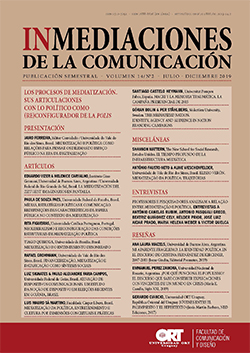Media, political strategies and communication. Redefinitions of the characteristics of public sphere in the context of mediatization
DOI:
https://doi.org/10.18861/ic.2019.14.2.2913Keywords:
Public place, communication, media, political strategies, mediatization.Abstract
This article is concerned with the redefinitions of the public sphere and their relationship with politics from an informational and communicational perspective. We will address these changes primarily through the eyes of two researchers who have devoted themselves to understanding the functioning of the public sphere in contemporary times: Bernard Miège and Peter Dahlgren. Our attention will be focused on the mutations that affected the public sphere, causing its fragmentation and expansion. This dynamic is explained by changes in communication practices, especially politics and journalistic practices in fostering democracy. These practices will be treated as prisms for understanding the public sphere since it depends, among other factors, on mediated interactions and exchanges.Downloads
References
Arendt, H. (1995). Qu’est-ce que la politique. Paris: Editions du Seuil.
Arendt, H. (2011). Condition de l’homme moderne. Domont: Calmann-Lévy.
Chartier, R. (2000). Les origines culturelles de la Révolution. Paris: Editions du Seuil.
Dahlgren, P. (1994). L’espace public et les médias, une nouvelle ère? Hermès, 13(14), 243-262.
Dahlgren, P. (2000). L’espace public et l’internet – structure, espace et communication. Réseaux, 100, 157-186.
Dahlgren, P. (2009). Media and Political Engagement. Citizens, Communication and Democracy. Cambridge: University Presse.
Gomes, W. (2008). Internet e participação política. In Gomes, W., Maia, R. C. M.
(Coord.), Comunicação e democracia (pp. 293-326). Sao Paulo: Paulus.
Habermas, J. (2008). L’espace public. Paris: Payot.
Habermas, J. (4 janvier, 2011). L’Europe malade de la xénophobie. Le Monde. Disponível em: https://www.lemonde.fr/idees/article/2011/01/04/l-europe-malade-de-laxenophobie_1460695_3232.html.
Kant, E. (2006). Réponse à la question: Qu’est-ce que les Lumières? In Kant, E. & Mendelssohn M. (Coord.), Qu’est-ce que les Lumières. Paris: Mille et une nuits.
La Haye, Y. (1984). Dissonances. Critique de la communication. Paris: La pensée sauvage.
La Haye, Y. (2005). Journalisme, mode d’emploi. Des manières d’écrire l’actualité. Paris: L’Harmattan.
Maia, R. C. M. (2008). Redes cívicas e Internet: efeitos democráticos do associativismo. Em Gomes, W. & Maia, R. C. M. (Coord.), Comunicação e democracia (pp. 327-348). Sao Paulo: Paulus.
Marchetti, D. (2005). La fin d’un Monde ? Les transformations du traitement de la politique étrangère dans les chaînes de télévision françaises grand public. In Dans, A. L. & Guionnet C. (Coord.), Les frontières du politique (pp. 49-77). Rennes: PUR.
Mehl, D. (2003). La bonne parole. Quand les psys plaident dans les médias. Paris: La Martinière.
Miege, B. (1997). La société conquise par la communication. La communication entre l’industrie et l’espace public. Grenoble: PUG.
Miege, B. (2010). L’espace public contemporain. Grenoble: PUG.
Neveu, E. (2006). Sociologia do Jornalismo. São Paulo: Edições Loyola.
Neveu, E. (2003). Métier politique: d’une institutionnalisation à une autre. In Lagroye, J. (Coord.), La politisation (pp. 103-121). Paris: Belin.
Nicolas, M. A., Sampaio, R. C., Bragatto, R. C. & Barros, S. (2016). Marco Civil da Internet: as duas fases da consulta on-line do Executivo em perspectiva comparada. In Mendonca, R. F., Sampaio, R. C. & Barros, S. A. R. (Coord.), Deliberação online no Brasil entre iniciativas de democracia digital e redes sociais de conversação. Salvador: Edufba.
Nollet, J. (2014). La production des décisions médiatiques. A propos de la crise de la vache folle en France. Savoir/Agir, 28, 39-44.
Paes, P. & Almeida, G. (2018). Quando a periferia cria sua própria mídia: perspectivas sobre cultura cívica na Internet. In Braighi, A. A., Lessa, C. & Câmara, M. T. (Coord.). Interfaces do Midiativismo: do conceito à prática (pp. 319-335). Belo Horizonte: CEFET-MG.
Primo, A. & Trasel, M. R. (2006). Webjornalismo participativo e a produção aberta de notícias. Contracampo, 14, 37-56.
Prudencio, K. & Batalha, M. (setembro-dezembro, 2009). Mídia ativista e ação política na internet: a experiência do Centro de Mídia Independente. ECO-Pós, 12(3), 100-122.





